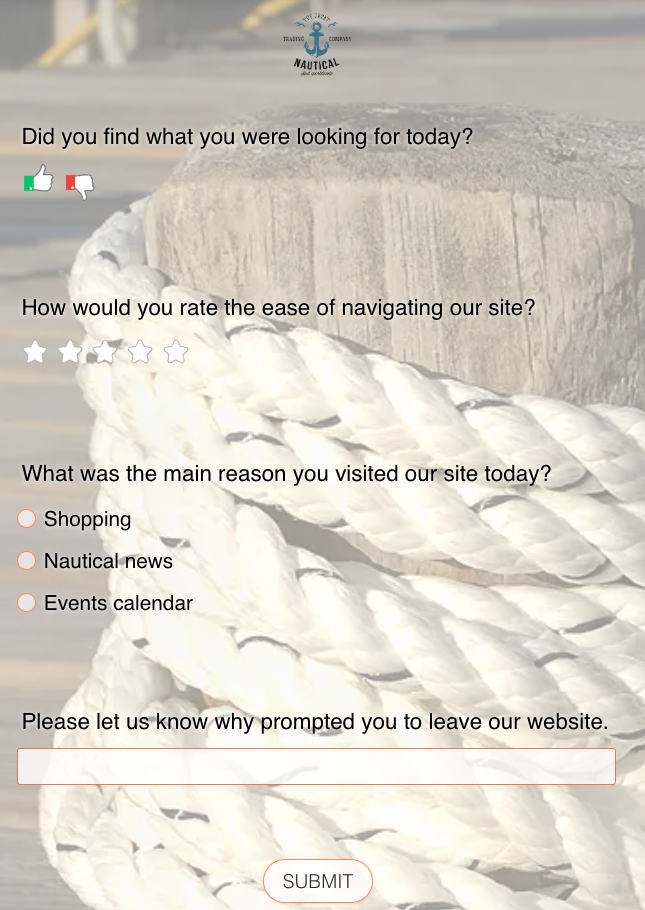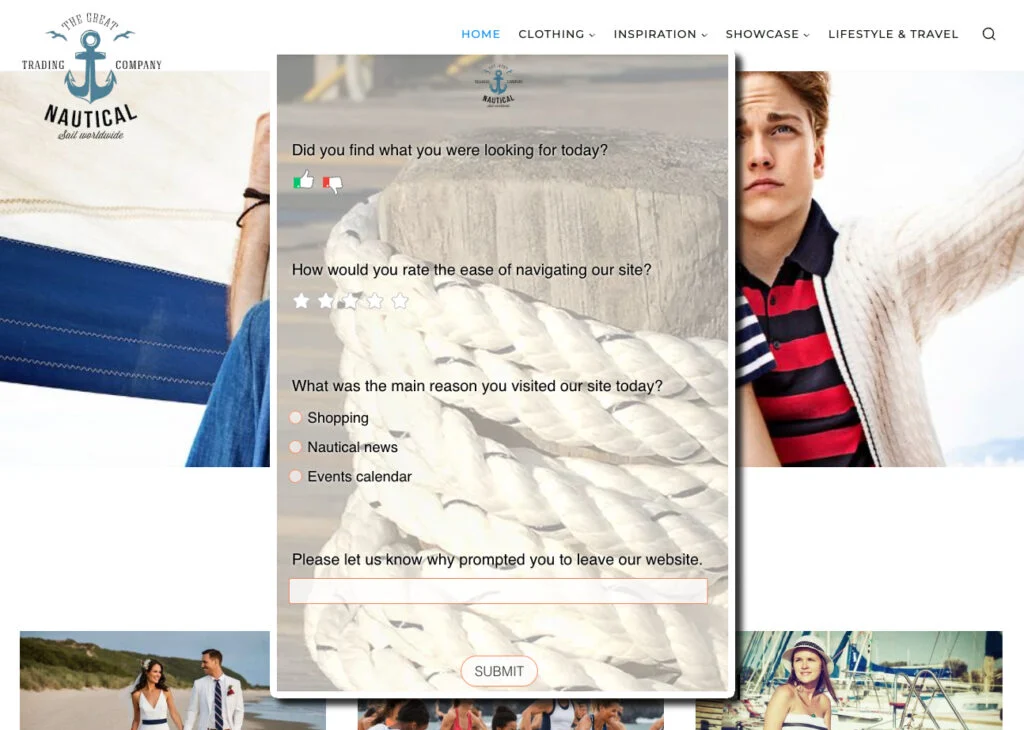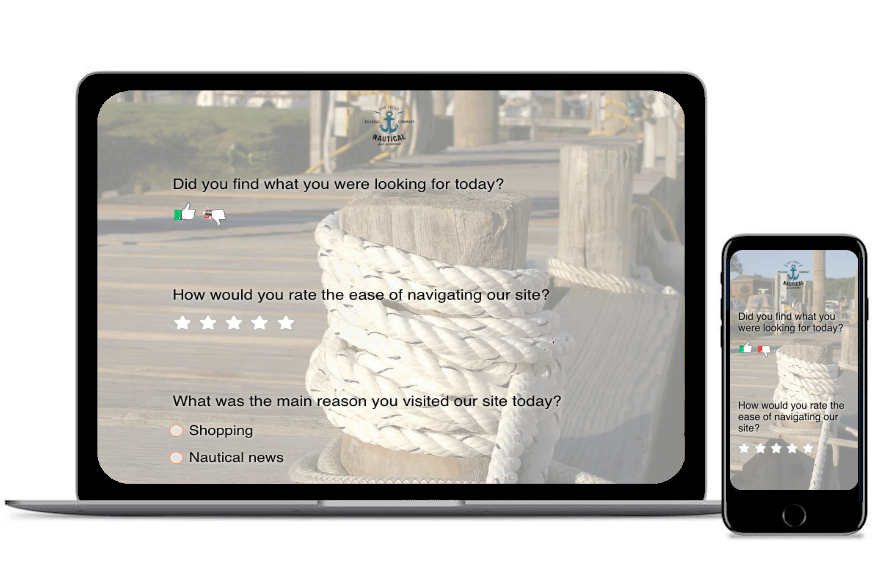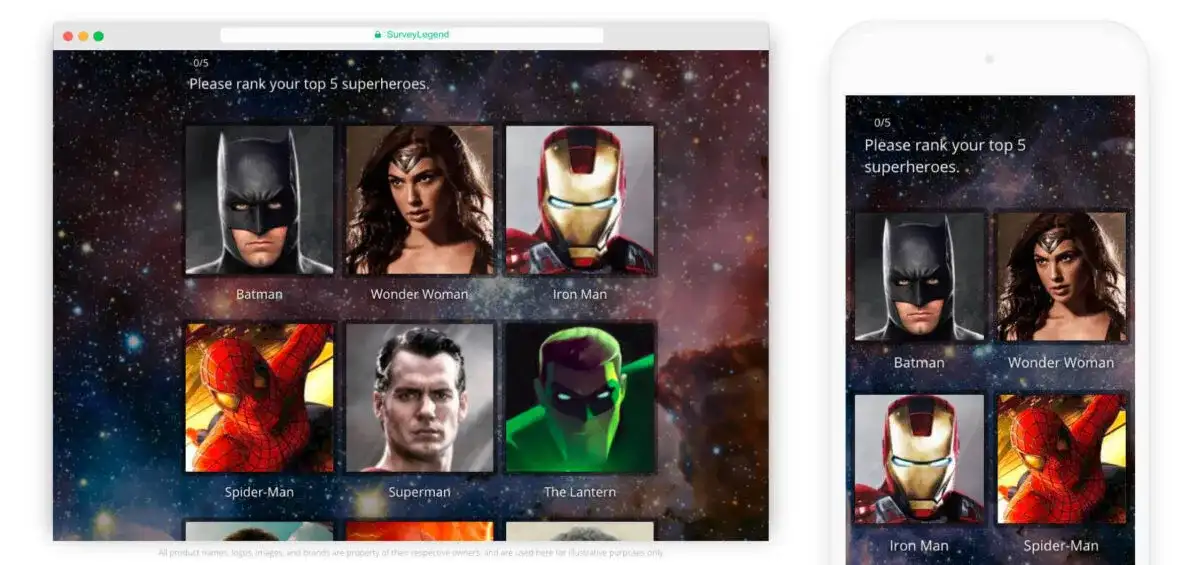“Hey, where you going?” In a nutshell, that’s the gist of an exit intent survey. These online surveys are designed to capture feedback from website visitors who are about to leave the site. Triggered by exit-intent technology, they typically pop up when a user is about to navigate from the site, for example moving their cursor toward the browser’s close button, back button, or address bar. But exit intent surveys can be very valuable to those employing them on their websites.
Create Your FREE Exit Intent Survey or Questionnaire Now!
What Is An Exit Intent Survey?
An exit intent survey is an online survey that appears just before the visitor leaves the site. It’s based on their behavior, such as cursor movement towards closing the browser or tab. Websites use them to gather immediate feedback about the visitor’s experience on the website, to understand why they are leaving, and identify any issues that may have prompted their departure in order to make improvements. Questions are generally very short (such as a microsurvey) and are directly related to the visitor’s experience (reasons for leaving, satisfaction with the site, suggestions for improvement, and so on).
Pros And Cons Of Exit Intent Surveys
Exit intent surveys can be a very valuable survey tool but that doesn’t mean they aren’t without some negative aspects. Here are some pros and cons to consider when deciding whether to implement these pop-up surveys:
Benefits Of Exit Intent Surveys
-
Capture Feedback at Critical Moments
Exit intent surveys capture feedback from users just before they leave your site, providing insights into why they may not have completed a desired action, for example making a purchase, signing up, subscribing, downloading a file, etc.
-
Gain Real-Time Insights
Because the survey appears immediately when the user is about to leave, they know exactly what prompted them to leave without recall issues that can cloud memory when a survey is sent days or weeks later. Therefore, responses tend to reflect users’ current experiences and sentiments. You may even find out that they’re leaving not because something is wrong with the site, but because they’re busy or just had to run.
-
Get Higher Response Rates
Compared to surveys presented at other times, exiting surveys can have higher response rates because they catch users’ attention when they are actively considering leaving. Be sure to check out our blog, How To Get Higher Survey Response Rates.
-
Discover Opportunity for Improvement
Insights gathered from website exit surveys can help identify pain points, usability issues, or content gaps on your website, allowing for improvements.
-
Engage Users
Exit intent surveys can engage users; they may appreciate having a platform to voice their opinions, especially if they encountered an issue or have suggestions for improvement. Knowing that their feedback could lead to positive changes can motivate users to participate. Additionally, by asking them why they are leaving, they may feel you care and that they are valued, potentially improving overall satisfaction.
-
Present Incentives
An exit intent survey offers you a last chance to keep the visitor on your site by offering an incentive. For example, if you’re an eCommerce site, the exit intent survey – in addition to asking why they are leaving – may offer a 10% discount to make a purchase right away, or to come back later and save with a coupon.
-
Create With Ease
Exit intent surveys are designed to be quick and to the point. So while you want to put thought into their timing, intrusiveness, and questions, they also don’t take a long time to develop or test (if you decide to test them).
Disadvantages of Exit Intent Surveys
-
Perceived Intrusiveness
Some users may find exit intent surveys annoying, feeling that they are intrusive or disruptive. This can be especially true if the exit intent survey pops up too often or covers critical areas of the webpage they are on.
-
Timing Issues
If the timing is off or if the user is in a hurry, they may find the survey inconvenient and choose to ignore or dismiss it.
-
Perception of Spam
If users encounter too many surveys on different sites, they might start viewing them as spammy and develop a negative attitude towards them.
-
Lack of Clear Value
Users may not see the immediate value in providing feedback, especially if they believe it won’t lead to any meaningful changes or if they have no personal stake in the website’s improvements.
-
Limited Insight
Responses to exit intent surveys tend to be brief to encourage people to take them, but they can be too brief. Simply asking “How’d you enjoy the site?” may be considered superficial, resulting in users dismissing it.
-
Sampling Bias
Users who are more likely to respond to exit intent surveys may not represent the broader user base, leading to sampling bias and potentially skewed insights.
-
Too Frequent
If an exit intent survey shows up every time a person visits the site, they can become frustrated with them. Create settings or implement cookies and other tracking mechanisms to limit how often the survey is shown to the same user.
Create Your FREE Exit Intent Survey or Questionnaire Now!
15 Questions To Ask On Exit Intent Surveys
The questions you ask on an the types of surveys may vary based on your objectives and goals (i.e., what is it you hope to learn from departing visitors?). However, here are some typical exit intent questions to consider.
General Experience
- “What was the main reason you visited our website today?”
- “Did you find what you were looking for on our site?”
- “Would you tell your friends or colleagues about our website?”
Reasons for Leaving
- “What is the main reason you are leaving our site today?”
- “Is there anything we could have done to keep you on our site longer?”
- “Do you expect to return to our website again in the future?”
Usability and Design
- “How would you rate the ease of navigation on our website?”
- “Was there anything you found confusing or frustrating about our site?”
- “How would you rate our website on a scale of 1-10?”
Conversion-Related
- “What stopped you from completing your purchase today?”
- “What can we do to improve your shopping experience?”
- “Why didn’t you sign-up/subscribe/download with us today?”
Incentive-Based
- “We’d like to offer you a 10% discount if you make a purchase now!”
- “Come back again and use the code COUPON24 to save next time!”
- “Wait! Sign up today and get a free [ITEM]”
Exit Intent Survey Example
Below is an example of a typical exit intent survey created with SurveyLegend. Using our online survey tool, you can add your logo (Nautical), background images (dock rope), and ask a variety of different types of survey questions to improve engagement and response rate (multiple choice, thumbs, stars, text).

Of course, this would pop-up on a website page when the visitor goes to leave, as seen below. Notice that it is not overly intrusive (visitors can still see behind the pop-up and access the main menu at the top).

Conclusion
Exit intent surveys are a valuable tool for understanding how people feel about your website by gathering real-time feedback from those preparing to leave. By implementing these surveys effectively, you can identify and address issues that may be driving visitors away, improving the user experience and ultimately increasing conversion rates. Ready to create your exit intent survey? Start today for free with SurveyLegend!
Have you used an exit intent pop-up on your website? Did it provide valuable insight? Do you fill out these quick surveys when presented with one? Let us know in the comments!
Create Your FREE Exit Intent Survey or Questionnaire Now!
Frequently Asked Questions
An exit intent survey pops up on a website page, triggered by a visitor trying to leave the page to find out how their experience was and why they are leaving. A cancellation survey is usually sent to a customer via email after they have canceled/unsubscribed to a subscription-based service to understand why they canceled the service.
Exit intent surveys may be created by an online survey company such as SurveyLegend. Larger companies may have internal user experience (UX) designers or marketing creatives implement them.
Use of exit intent surveys varies depending on the type of website, its audience, and its goals. Websites focused on e-commerce, SaaS (Software as a Service), and content publishing often use them more frequently to capture feedback before users leave the site.



